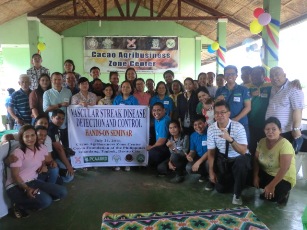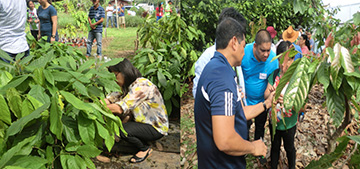 The cacao industry has great potential in the Philippine market, not only as a source of food but also as a good source of medicines. However, the industry is now facing disease management threat.
The cacao industry has great potential in the Philippine market, not only as a source of food but also as a good source of medicines. However, the industry is now facing disease management threat.
Addressing this concern, government and private agencies worked together to better understand, detect, and control the Vascular Streak Dieback (VSD) through a hands-on seminar.
Held recently at the Cacao Agribusiness Zone Center, Cocoa Foundation of the Philippines, Inc. (CocoaPhil), Talandang, Tugbok, Davao City, the hands-on seminar sought to disseminate information on management and detection of VSD through biological-based approaches.
VSD has been found in most cocoa-growing areas in South and Southeast Asia, and Papua New Guinea. It has been a major problem in the large commercial plantations in West Malaysia and Sabah. It is widespread in Indonesia, including in the cocoa plantations in East and West Java. Cases of VSD are also reported from Southern Thailand, Burma, Vietnam, and the Southern Philippines.
When cacao tree is infected with VSD, irregular patch or unsightly marks appear on its leaves until they deteriorate. The deterioration begins from the second or third flush behind the shoot apex. Eventually the shoot apex as well as the infected branches die. The fungus may grow through the xylem down into the main stem and kill a mature cacao tree.
According to Dr. Dionisio G. Alvindia of the Philippine Center for Postharvest Development and Mechanization (PhilMech), early detection is very important for the control of the disease. Alvindia added that to manage the disease, biological control is being developed in a program titled, Cacao Pest Management Program: Biological-based Approaches, which is being implemented by the De La Salle University (DLSU), University of the Philippines Los Baños (UPLB), and is funded by DOST-PCAARRD. A VSD pictorial guide was provided during the seminar to initially aid the farmer-participants on VSD detection both on cacao seedlings and planted trees.

Dr. Alberto T. Barrion, one of the Cacao Pest Management project leaders, stressed the importance of using biological-based approaches as a better and sustainable strategy in managing pests and diseases of cacao compared with the chemical-based control methods.
Fifty participants from both government and private agencies and local cacao farmers attended the seminar. Aside from the lectures and presentations, the participants also engaged themselves on hands-on activities during the cacao nursery and plantation visit.
Among the participants during the seminar are representatives from De La Salle University (DLSU), UPLB-BIOTECH, Isabela State University (ISU)-Echague, University of Southern Mindanao (USM), DOST-CAR, DOST-PCAARRD, DA (PHilMech, BPI, RCPC XI, RFO XI, QARES-RFO R4), Davao City Agriculture Office, OPAG-Davao del Sur, Cacao Industry Development Association of Mindanao, Inc. (CIDAMI), CocoaPhil, and local cacao farmers.
The Philippine Council for Agriculture, Aquatic and Natural Resources Research and Development of the Department of Science and Technology (DOST-PCAARRD) is supportive of the cacao industry, being one of the priority crops under its Industry Strategic Science and Technology Programs (ISPs). The program seeks to further develop the cacao industry through science-based solutions and innovations.
